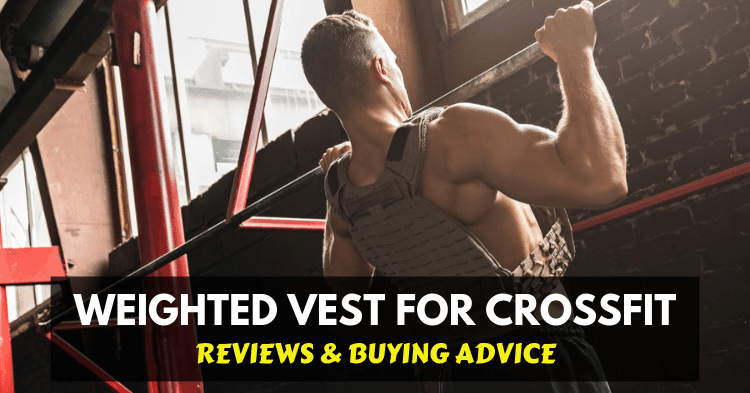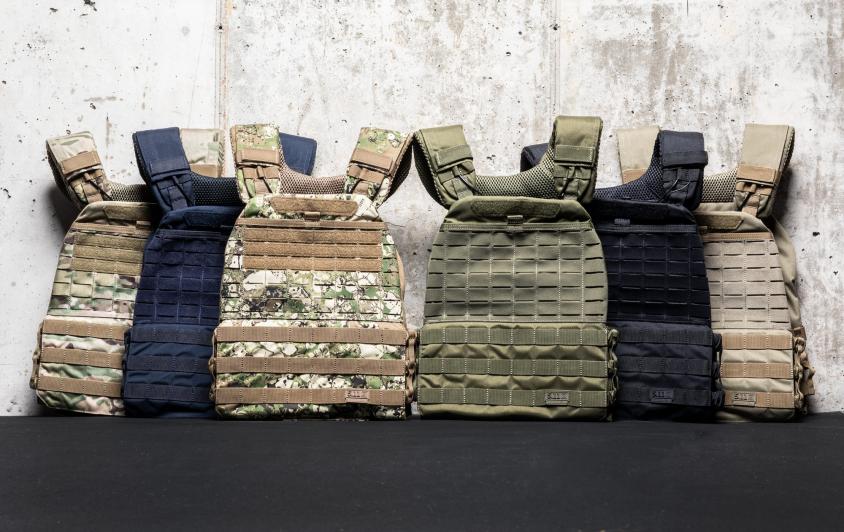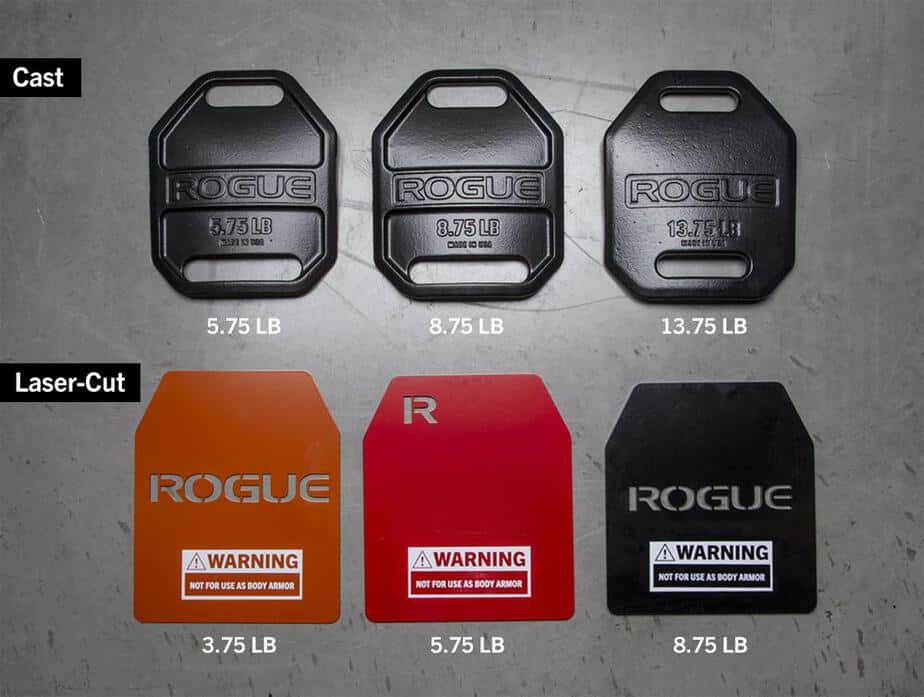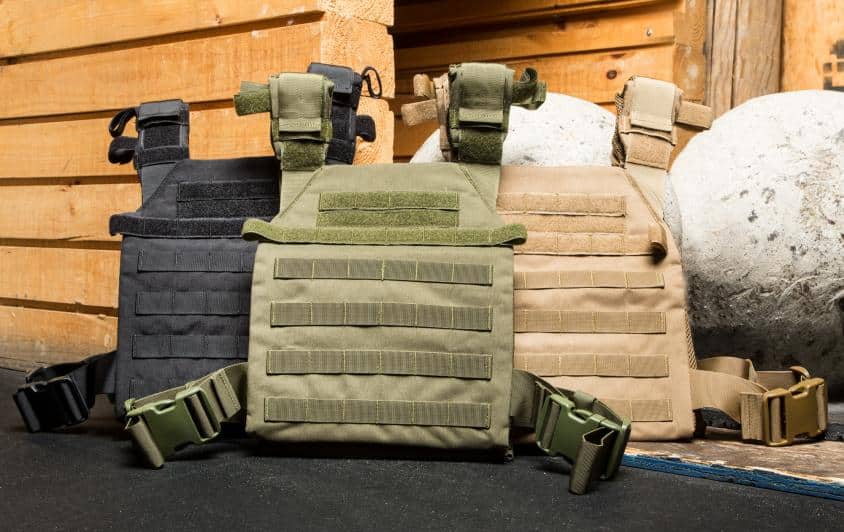
What’s better than moving well? Moving well with weight.
The introduction of a weighted vest allows you to train more effectively for CrossFit, Gymnastics, and general S&C. The ability to weight your body can make exercise more challenging to produce better results, and keep you progressing when you’re just too damn strong for bodyweight!
We’re going to discuss some of the most popular weighted vests on the market, what you should look for in a Weighted vest for CrossFit and answer all your questions on this niche piece of fitness equipment!
Top Weighted Vests for Crossfit & Murph WOD
1. Rogue 5.11 TacTec™ Plate Carrier Vest

This is one of the most recognizable and respected products on the market. It’s a plate-loaded weighted vest at the front and rear of the product.
The design is ergonomic to replicate the ballistic vest design seen in military/police use. This has been refined repeatedly and the comfort of this product is a great selling point.
It also comes with a variety of weights if you are willing to buy the plates.

The different plates allow you to load this weighted vest up to 30lbs. This is a decent weight and can be useful for gymnastic strength training, as well as weighted CrossFit movements. You can get these plates from rogue, but they also support other plates from the “small arms protective insert” category.
This product is clearly purpose-produced for CrossFit style training and – if that’s your goal – then this product will be specific to your needs. The comfort is great, and the overall design philosophy/specificity is great.
- Reputable brand
- Great, intentional design
- Adjustable weight and quality loading options
- Ergonomic for the intended purpose
- Can be too restrictive for certain exercises
2. Rogue Condor Sentry Plate Carrier

The Condor Sentry plate carrier is a smaller version of the 5.11 tactical vest we’ve just discussed. It’s a smaller, more mobile version that may be better-suited for general movement. While the design isn’t as faithful to the ballistic vest, it’s convenient and ergonomic.
The weight options are the exact same as the 5.11 vest, from 14lbs to 30lbs total weight with different plates being available. This does not use the standard SAPI inserts, however, so you’d need to purchase them from Rogue specifically.
We prefer this product for the ergonomic, low-restriction movement it allows. While still plate-loaded, it ensures that a significant amount of the weight and rigidity is centered over the sternum. This means that movement in the spine is less-restricted and may be more comfortable.
This is a better alternative for fitness if you’re not concerned about being high-fidelity to military fitness training. We think this is more suitable for most people.
- Better sizing
- Less likely to rub or cause significant discomfort
- Better ergonomics for gymnastic training
- Still plate-loaded, restricting certain movements
3. RUNmax Weighted Vest

This is a more classical approach to the weighted vest. It includes a much larger range (from 12 to 60 pounds), as well as being strapped for calisthenic movements. This doesn’t mean it’s perfect, but it does provide more consumer choice (which we like).
This has a modular weighting, which means the vest is not loaded in a restricting way. It provides weight across the whole product all the time and doesn’t have the same rigidity as the rogue plates.
This product also has a standard weight which can be adjusted. You can make a 60lbs vest lighter by removing the weights and produce a versatile amount of weight that suits your strength, needs, and the exercises you’re trying to load.
One problem is the lack of effective padding in the shoulders, where the weight rests, and the poor adjustability of the straps. These are significant concerns for comfort, which mars an otherwise great product.
- Larger range
- Ingot-loaded for better ergonomics and movement freedom
- Adjustable weight
- Poor shoulder-padding and support
4. Cross101 Adjustable Weighted Vest

This product comes with a huge range, from 20lbs to 140lbs. We’re not sure what you’re doing with a 140lbs vest, but the option to have one is pretty cool – more choice is good.
The design of this product is both slimline and quite aesthetic, with a selection of designs on offer. The overall width is much smaller than the 5.11 vest. The weighting is somewhat restrictive but no more than the standard ballistic vest design.
The problem with this product is that the straps make it difficult for running. In many ways, this is much better for the purposes of gymnastic strengthening than general fitness. However, restriction through the torso does mean that it’s going to be mildly uncomfortable for both purposes.
The range and design are good, but we’re not entirely convinced by the Cross101 Weighted vest as it’s imperfect for endurance and gymnastic strength training.
- Enormous weight range
- Decent design
- Mildly restrictive but no more than other weighted vests
- Restriction through the lower torso does mean there might not be perfect performance in certain exercises
5. Titan Fitness Adjustable Weighted Vest

This weighted vest has a standard range of 20-60lbs, which offers a good amount of resistance without being excessive. The weights are square ingots, which allows for minimal restriction through the torso while wearing.
The actual product is very small, too, which reduces the impact on the lower torso movement. This is great for gymnastic strength training, where hollow, rotational, and non-neutral spine positions need to be trained.
This product, thus, provides a great choice for a small, effective weighted vest that you can load yourself with, without worrying about impinging movement! Overall, this product is durable and versatile, so we’re big fans!
- Very small
- Adjustable and ingot-loaded
- Versatile and appropriate for gymnastic strength training
- No significant problems with this product
6. MIR Women’s Adjustable Weighted Vest

The design of this product looks hilarious, but the concern for reducing the pressure on the glandular tissues of the female chest is actually really welcome. Applying weight and pressure to the chest can easily cause damage to the breasts – especially if performed regularly.
This product attempts to relieve that pressure and the size & design are good for keeping weight away from the lower torso. In this way, reductions in breast-pressure and movement-limitation are good with the MIR weighted vest.
The range is smaller at 10-50lbs, but the main problem with this product is the discomfort and difficulty. Strap-design appears to be very poor, the Velcro attachments are common sources of complaint, and the securing rings often cause pain by digging into soft tissues.
A great design idea, but poorly-implemented!
- Good concept and the conscious approach to female weighted vests
- Smaller range
- Implementation is poor
- Uncomfortable and often causes significant irritation
7. ZFOSports Weighted Vest

This weighted vest is much longer than some other products on this list like the titan vest. This makes it a bit of a problem for movement since the lower torso is restricted and the 40lbs version also seems to sit into the crease of the hip (which is awful).
The strap for securing this product is also large, bulky, and oddly wide. This should be minimized since more fabric in this region only serves to reduce movement further and makes any flexion of the spine uncomfortable.
This product makes sense if you’re getting the 20lbs, smaller vest. However, everything above that begins to introduce significant problems in use. An uncomfortable weighted vest is a very bad choice and this product seems to be a real risk to limited movement and the injuries/irritation this can cause.
Overall, we’re not sold on this product. We think there are many better alternatives on this list!
- Comparatively, this product does not have distinctive benefits
- Very long at 40lbs and above
- Strap is enormous and bulky and restrictive
Weighted Vest Buying Advice
The weighted vest is a versatile and hard-wearing piece of equipment if you get it right. However, it’s easy to get a low-quality product with the flood of interest on the market. So what makes a good Weighted vest for CrossFit and how can you tell what you should be spending your money on?
Plate Carrier vs Weighted Vest
The first question you need to ask yourself is whether you want a plate carrier or a standard micro-weighted vest. These both add weight to your body, but they have very different practical uses.
The weighted vest is used primarily because it allows you to weight the body without changing the center of balance. These contain many, small weights to provide adjustable resistance without limiting movement in a significant way.
This allows you to train gymnastics and bodyweight movements without changing how they feel and perform.
The plate carrier doesn’t do this – it adds a pair of metal plates to a vest to provide resistance. For most purposes, this is fine, but it does require rigidity in the torso which can be a problem. This can significantly change the mechanics of your movements and may affect how you perform gymnastic skills that aren’t straight-torso.
This makes the weighted vest a better option for most people most of the time. However, if you’re specifically planning to use a plate carrier for CrossFit purposes like running and pull ups, it should be fine.
Of course, you have your own goals and needs, so it’s up to you. However, it’s important to note that these are different products and will produce markedly different experiences in training.
How Much Weight Should a Weighted Vest for CrossFit Be?
Many weighted vests in CrossFit are in the range of 20lbs to 33lbs. The 20lbs vest is famous because of its role in the Murph workout, which has been a test of fitness in CrossFit for over a decade.
This workout uses the 20lbs weighted vest, which is a little smaller than standard. However, the standard 15kg/33lbs weighted vest often contains small weights and can be reduced to 20lbs for specific workouts.
For this reason, it’s sensible to buy a heavier weighted vest that can be lightened than a lightweight vest. If you’re buying a 20lbs weighted vest, especially one that doesn’t allow you to adjust the weight itself, you’re going to struggle to load gymnastic movements effectively.
At a minimum, you want a 20lbs vest – any less will be too light. However, since training gymnastics for CrossFit is a significant part of training, you should consider getting a product that is adjustable for better gymnastic strength training.
How Much Does a Murph Vest Weight?
The small weighted vests that you’ll see at CrossFit games during a Murph workout are 20lbs. These are often custom-made for the games, and they’re significantly smaller than the normal weighted vest you’ll run into at a gym.
You can buy these specifically-sized 20lbs Rogue weighted vests, as discussed above. However, their size can be a serious limitation for other activities, as mentioned above, so make sure you consider what you want to do with your weighted vest.

Comfort
You’re going to be doing a lot of activity in these heavy, clunky weighted vests. The last thing you need is some military-grade strap rubbing against you throughout and causing irritation.
This is a problem we see with low-quality products and it’s a concern for your workouts. Anything that distracts you from the workout is a negative, since results are the #1 factor in a good piece of equipment.
A weighted vest that is comfortable to wear and provides sensible strap-placement is key. If you’re doing a workout like Murph, with 2km of running and 600 other reps, then biting straps and discomfort are only going to make everything worse.
The main focuses for better comfort will be strap placement, padding quality, design quality, and a thoughtful approach to how it feels to be wearing a vest during a workout!
Reliability
This isn’t the same as durability. While the two are linked, what this is really about is providing the same benefits repeatedly and the peace of mind you’re not going to fall apart during a workout.
The build quality and design of a good weighted vest has to keep the weights in the vest and keep the vest on your body as closely as possible. Any product that can’t do this reliably workout-after-workout is going to be a challenge to use.
You need to be able to perform your workout without worrying about your vest coming off, losing weight, or any other freak change. This is why reliability in design and manufacture are crucial to a good weighted vest or plate carrier!
Weight Distribution
This is one of the factors that often trips up otherwise good-quality plate carriers. It’s also a concern for weighted vests, however, where poor design can easily lead to wobbly weight distribution.
This is a problem for any workout or exercise that requires you to control your own weight. T’s mostly a concern for technique and performance in complex movements like Gymnastic training, where balance is very specific and part of the challenge!
Products that don’t distribute weight properly will feel awkward and can easily ruin a workout. Needless to say, this isn’t what you want in a weighted vest and it’s going to make any product less worthwhile.
Running With A Vest: Yes Or No?
The great debate around weighted vests is whether or not they are good for running.
Wearing them during running does increase the metabolic cost, which means you will burn more calories than without it.
However, that may come at a cost to your knees. Studies have shown that added load changes the way we walk and run, and not for the better.
The takeaway is: be careful to add the load slowly and if you have previous injuries or issues, stick to low impact activities, such as incline walking.
If you are not in the army or in a similar job which requires you to be prepared for weighted carries, stick with lighter weights if you still want to go running with it.
Conclusion
Overall, we’re big fans of weighted vests. They allow you to load your body in a natural, balanced way, when they’re done right. We’ve already highlighted the strengths and weaknesses of different products, but the overall theme is that quality and thoughtfulness of design are the key components for a great weighted vest!
With that said, Rogue’s Condor Sentry vest is clearly the best plate-carrier, while the Titan weighted vest is our favorite ingot-loaded vest. These serve totally different niches, but we do really like the Titan model’s small size, non-restriction, and the exercise variety it allows for.
The Rogue condor is a good choice if you know you’re specifically looking to use a weighted vest for CrossFit workouts like Murph. Better for running, less appropriate for gymnastic strength training.
Putting your time and money into training with a weighted vest can be a significant boost for CrossFit and Gymnastics/Bodyweight training. Getting good at moving with your body is key, and the weight vest allows you to practice this under load in a natural and productive way!